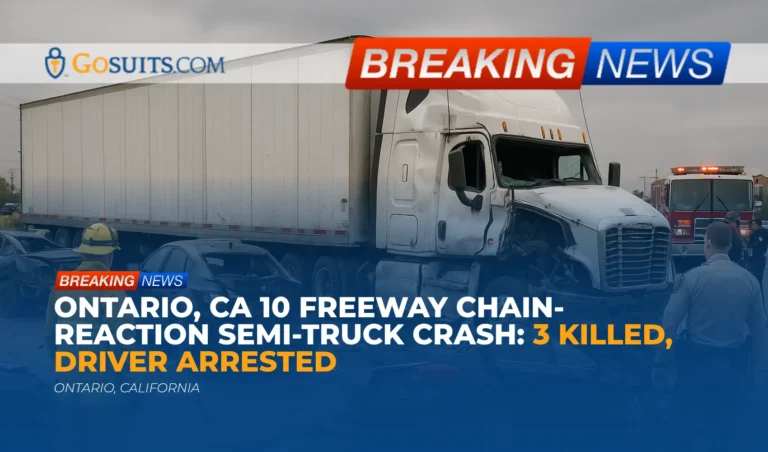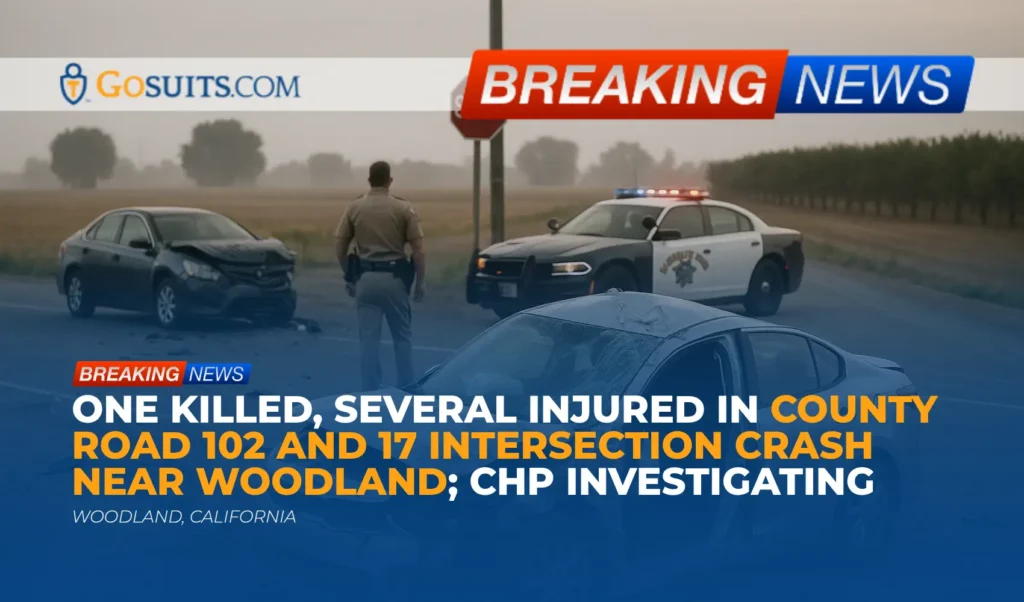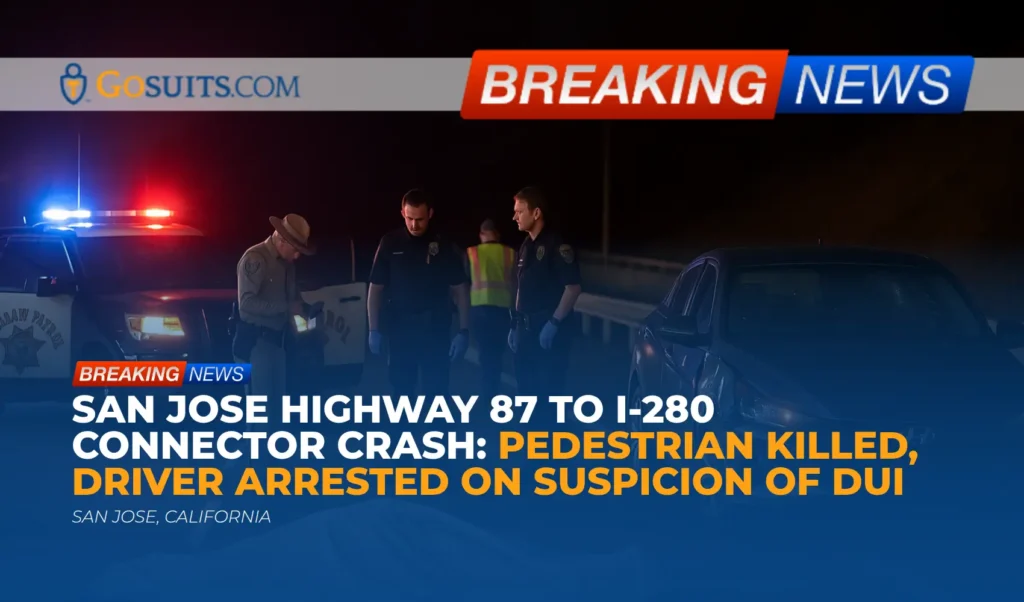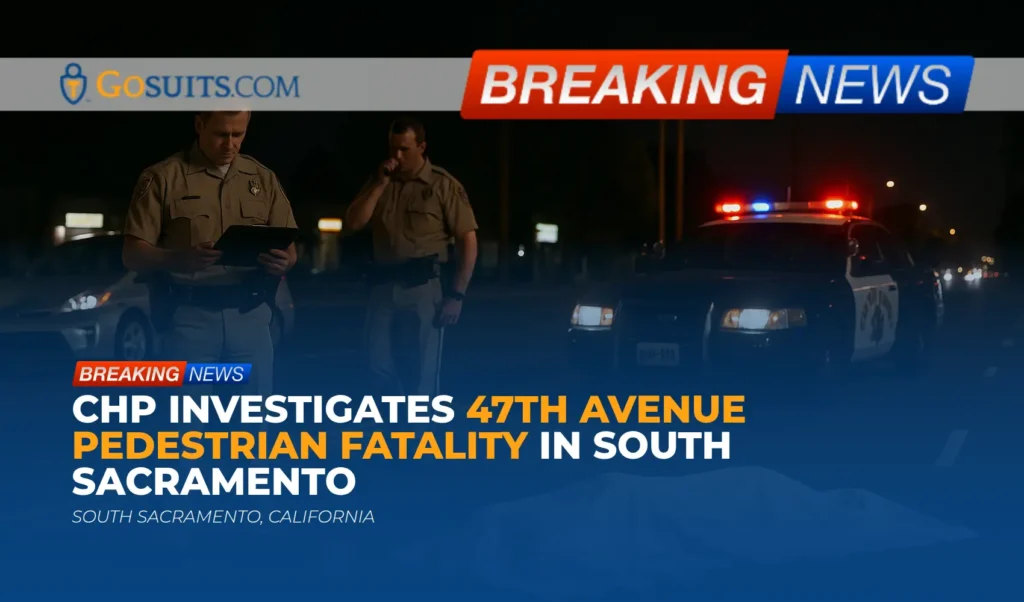- What we know about the 10 Freeway chain-reaction crash in Ontario, California
- Who was involved and the status of the investigation
- Why chain-reaction crashes with big rigs are so devastating
- Immediate information and assistance: where to obtain official records and updates
- Civil liability after a multi-vehicle truck crash in California
- Rights of those harmed: injury and wrongful death claims in California
- Safety and prevention context
- What to do before speaking with any insurance company
- Press and social media rumors
- Commentary from Gosuits Ontario, California Personal Injury Attorney
- Why timely action matters after a catastrophic truck crash
What we know about the 10 Freeway chain-reaction crash in Ontario, California
On a recent Tuesday, a semi-truck traveling on California’s 10 Freeway in Ontario reportedly collided with slowed traffic, triggering a chain-reaction crash that involved eight other vehicles. Three people were pronounced dead at the scene. At least four others were transported to nearby hospitals for treatment. Officials have indicated that the truck’s driver, a 21-year-old from Yuba City, was arrested at the scene. Law enforcement has publicly stated that impairment is suspected, and the driver was booked into the West Valley Detention Center in San Bernardino County. The investigation is ongoing, and authorities are working to reconstruct the sequence of events, identify contributing factors, and determine whether any mechanical, human, or environmental issues played a role. As is common in multi-vehicle freeway collisions, the crash area saw a significant emergency response. Traffic closures and scene reconstruction efforts likely lasted hours. The identities of those who died and the current conditions of the injured have not been publicly detailed by officials as of the latest available information.
Who was involved and the status of the investigation
Preliminary reports indicate the crash involved a semi-truck and eight additional vehicles in congested traffic on the 10 Freeway in Ontario. Three victims died at the scene. Several others were injured and transported for medical care. The truck driver, identified by authorities as being 21 years old and from Yuba City, was arrested at the scene and booked. Authorities have signaled potential charges, including vehicular manslaughter and suspicion of driving under the influence of drugs. It is important to understand that these are allegations at the investigative stage. No criminal case outcome has been determined at this time. From a civil standpoint, investigations into impairment, braking, speed relative to traffic, driver fatigue, and compliance with trucking safety rules are commonly part of the fact-finding process after a high-impact crash. Officials have not released an official booking photo as of the latest public statements. An image circulating on social media has been described by officials as unverified. Families and community members should rely on official updates rather than speculation circulating online.
Why chain-reaction crashes with big rigs are so devastating
Multi-vehicle crashes involving large commercial trucks are often catastrophic for several reasons. Large tractor-trailers can weigh up to 80,000 pounds when fully loaded. In congested traffic, even a relatively modest speed differential can generate massive forces on impact. If a truck does not slow in time for stopped or slowed vehicles, the initial impact can push vehicles forward into others, setting off a cascade of collisions that multiply damage and injuries. Visibility, driver attention, speed relative to traffic conditions, braking distance, and vehicle maintenance are all central issues. For example, commercial drivers are subject to federal regulations governing hours of service and fatigue management, and motor carriers must ensure drivers are qualified, trained, and fit to operate. Post-crash reviews typically focus on whether the driver was alert, unimpaired, and operating within safety regulations, and whether the truck was properly maintained with functioning brakes, tires, and safety systems.
Immediate information and assistance: where to obtain official records and updates
Police collision report
For crashes on California freeways, the California Highway Patrol (CHP) typically investigates and maintains the official collision report. Involved parties and their legal representatives can request a copy by submitting the CHP 190 form with necessary details such as the date, location, and parties involved. Guidance on obtaining a CHP collision report is available at the CHP’s official page: CHP collision reporting and investigation. The report often includes diagrams, statements, and contributing factors noted by the investigating officer. Processing times vary, especially for fatal collisions that require additional review.
Coroner’s findings, autopsy, and next-of-kin support
For deaths that occur in San Bernardino County, the Sheriff-Coroner’s Department manages decedent identification, cause and manner of death determinations, and communication with next of kin. Families can review procedures for notifications, autopsy reports, and how to request coroner records through the department’s website: San Bernardino County Sheriff-Coroner. Autopsy and toxicology results can take weeks or longer, depending on laboratory timelines. The coroner’s office can also provide guidance on release of remains and coordination with funeral homes.
Detention and booking information
Individuals booked into San Bernardino County facilities, such as West Valley Detention Center, fall under the jurisdiction of the Sheriff’s Department. While this does not directly affect civil claims, members of the public can find general custody and inmate information through official county channels hosted by the Sheriff’s Department.
Hospital records and privacy rights
Medical records for those injured are protected by federal privacy rules. Patients, or authorized representatives, can request copies of their records from the treating hospital or clinic. The U.S. Department of Health and Human Services provides an overview of patient rights to access medical records here: HHS medical records rights. These records can be vital in documenting the nature of injuries, treatments received, and anticipated future care needs.
Traffic management and road closure updates
For official traffic and road closure information in California, Caltrans provides real-time statewide updates via QuickMap: Caltrans QuickMap. After major incidents, this resource can help understand closures and detours while investigators work at the scene.
Victim compensation in California

California’s Victim Compensation Board may assist eligible victims and families with certain out-of-pocket expenses, such as funeral costs and counseling, subject to program rules. Information on eligibility and applications is available at California Victim Compensation Board (CalVCB). This is separate from any civil insurance claims or lawsuits.
Civil liability after a multi-vehicle truck crash in California
When a catastrophic freeway crash involves a commercial truck and multiple vehicles, several parties may be examined for potential civil responsibility. Which parties are actually liable depends on the facts uncovered by investigators and, if pursued, through civil discovery. Potential parties can include the driver, the motor carrier that employs or contracts with the driver, maintenance providers, freight loaders, and in some cases product manufacturers or governmental entities if a hazardous roadway condition is alleged.
Potential theories of responsibility
– Negligence by the driver: Failing to slow for traffic, inattention, impairment, or unsafe following distance are examples of conduct that may constitute negligence if proven. – Vicarious liability of the motor carrier: Employers and motor carriers can be held responsible for the negligence of their drivers acting within the course and scope of employment. – Negligent hiring, retention, or supervision: If a motor carrier puts an unfit driver on the road or fails to supervise or train adequately, civil responsibility may attach if those failures contributed to the crash. – Vehicle maintenance failures: Defective or poorly maintained brakes, tires, or lighting systems can contribute to collisions. Maintenance records and inspection logs become critical. – Cargo loading issues: Improperly secured or overloaded cargo can increase stopping distances and destabilize the rig. Bills of lading and loading records can be important evidence. – Roadway conditions: In limited cases, a governmental entity could be implicated if a dangerous condition of public property was a substantial factor in causing the crash. Special notice rules apply to such claims under California law.
Evidence that often proves fault in truck cases
– Electronic data: Engine control module data, electronic logging device hours-of-service data, GPS tracks, and dash camera footage. – Driver cell phone records: To assess potential distraction or calls and texts just before impact. – Drug and alcohol testing documentation: Federal regulations require post-accident testing for CDL drivers in certain circumstances. See FMCSA Part 382 for controlled substances and alcohol testing requirements, including post-accident testing criteria. – Inspection and maintenance files: Federal and state rules require pre-trip inspections and regular maintenance. Logs and work orders may show whether defects were addressed. – Load documentation: Bills of lading, weight tickets, and shipper or loader records can clarify whether cargo contributed to the outcome. – Scene forensics: Skid marks, crush profiles, vehicle rest positions, and debris fields help reconstruct speed, braking, and impact sequence.
Insurance coverage and policy-limit challenges
Commercial motor carriers engaged in interstate commerce must carry minimum levels of financial responsibility under federal rules. Coverage requirements vary by cargo and operation, but often start in the hundreds of thousands of dollars and can be higher for certain freight classes. See FMCSA financial responsibility rules for baseline requirements. After multi-injury, multi-fatality events, policy limits can be strained, and multiple claimants sometimes must pursue recovery from several avenues. Insurers may attempt early contact to obtain statements or medical authorizations. It is prudent for those affected to consult a qualified attorney before speaking with any insurance company, as statements can be used to limit or contest claims later.
Rights of those harmed: injury and wrongful death claims in California
California law provides a path for those injured and for families who have lost a loved one to pursue civil remedies. The specific claims and who may bring them depend on the facts and the relationship to the decedent. – Wrongful death: California’s wrongful death statute identifies who may bring a claim, typically certain family members and dependents. See Code of Civil Procedure section 377.60. Damages can include economic losses such as financial support that the decedent would have provided and the value of household services, as well as non-economic loss related to the relationship. – Survival action: The decedent’s estate may pursue claims the decedent could have brought had they lived, such as pre-death medical expenses and conscious pain and suffering where allowed. See Code of Civil Procedure section 377.30. – Statute of limitations: In many California injury and wrongful death cases, the general deadline to file a lawsuit is two years from the injury or death, per Code of Civil Procedure section 335.1. There are exceptions, so timelines should be reviewed carefully. – Claims involving public entities: If a claim involves a dangerous condition of public property or a public entity, a government claim must usually be filed within six months in California, with limited exceptions. See Government Code section 911.2. Damages in severe truck crash cases can include medical expenses, lost income and earning capacity, funeral and burial expenses, property damage, and non-economic harms such as loss of companionship in wrongful death matters. Each case turns on its specific facts and applicable law.
Safety and prevention context
Impaired driving remains a primary cause of preventable roadway deaths. National highway data underscore that alcohol-impaired driving fatalities account for a significant proportion of traffic deaths each year. For background on the risks and national trends, see the National Highway Traffic Safety Administration’s impaired driving resources at NHTSA Drunk Driving. Commercial trucking operations are subject to federal safety rules designed to reduce these risks. Key frameworks include: – Controlled substances and alcohol testing: Part 382 of the Federal Motor Carrier Safety Regulations requires employers to conduct pre-employment, random, reasonable suspicion, and post-accident testing under defined circumstances. Guidance is available at FMCSA Part 382. – Hours of service and fatigue: Drivers must adhere to limits on driving and on-duty time to mitigate fatigue, with records maintained via electronic logging devices in most cases. A summary of these rules is at FMCSA Hours of Service. When a catastrophic crash occurs, investigators commonly review compliance with these rules, as well as maintenance and inspection histories, to determine whether safety breakdowns contributed to the collision.
What to do before speaking with any insurance company
Insurance carriers and corporate risk managers often act quickly after a major collision. They may reach out to those involved, including families, for statements or medical authorizations. It is prudent to understand rights and obligations before engaging. – Consult an attorney first: Speaking with a qualified attorney before contacting any insurer can help protect legal rights and clarify options. What is said to an insurance company can be used to reduce or deny claims later. – Do not sign broad releases early: Early medical or blanket authorizations can expose entire medical histories that may be used to dispute causation or damages. – Preserve evidence: Maintain vehicles, photos, dashcam footage, and personal items. Keep copies of receipts, repair estimates, and medical bills. – Document symptoms and impacts: Maintain a timeline of symptoms, missed work, and daily limitations. – Limit social media: Online posts can be misconstrued or taken out of context by insurers. – Track communications: Keep a log of calls and letters from insurers, trucking companies, and investigators.
Press and social media rumors

After high-profile crashes, social media often circulates unverified photos and claims. Officials in this matter have not confirmed the authenticity of a widely shared image purported to show the arrested driver. It is sensible to wait for official releases from law enforcement and to rely on the CHP report and the coroner’s findings for verified facts. Public commentary that speculates about causes or motives does not substitute for a thorough investigation and can be distressing for those affected.
Commentary from Gosuits Ontario, California Personal Injury Attorney
Our hearts are with everyone affected by the tragic chain-reaction crash on the 10 Freeway in Ontario. Lives were lost and others were forever changed in moments. This overview is intended for general information and education to help the community understand how investigations unfold and what steps can support accountability and healing. Based on the preliminary information that a semi-truck entered slowed traffic and triggered a multi-vehicle collision, investigators will likely focus on whether the driver’s condition, speed relative to traffic, and braking were appropriate for the congestion ahead, as well as whether the motor carrier’s safety practices met federal and state standards. In large-loss events, the analysis typically extends beyond the individual behind the wheel to include training, supervision, hours-of-service compliance, maintenance records, and post-accident testing and reporting. In our experience, insurance companies and corporate defendants often act quickly to protect their financial exposure. Early statements can be parsed, recorded calls can be used to minimize injuries, and requests for sweeping medical authorizations can be used to comb through histories to argue that harm was preexisting. Complex coverage issues, including multiple policies and competing claims, can make it challenging for families to secure the resources they need. A free consultation with a seasoned attorney can help clarify rights, identify critical evidence to preserve, and outline next steps before engaging with insurers.
Why timely action matters after a catastrophic truck crash
– Evidence can be lost if not preserved quickly: Electronic control module data, dashcam footage, and even truck telematics can be overwritten or lost. Prompt evidence preservation requests help ensure critical data is maintained. – Witness memories fade: Early contact information and statements from witnesses can be decisive in multi-vehicle collisions where viewpoints differ. – Vehicles may be destroyed or repaired: Towing yards move fast. Securing inspection access before vehicles are altered helps experts assess crash forces, brake condition, and restraint systems. – Medical documentation starts from day one: Thorough and timely medical evaluation connects symptoms to the collision and supports appropriate treatment planning. – Multiple claimants compete for limited insurance: In a multi-injury event, policy limits can be reached quickly. Early action helps position claims for available coverage and preserves other recovery avenues that may exist. – Legal deadlines apply: California sets deadlines for filing civil actions and, when applicable, early claims against public entities. Understanding these timeframes early helps avoid forfeiting rights. – Accurate communications protect claims: Before speaking with insurers, clarifying what to say and what to avoid reduces the risk that recorded statements will be used to minimize responsibility or damages later on. – Agency records take time: CHP collision reports, coroner findings, and medical records are central to civil claims, but each can take weeks or months. Initiating requests promptly keeps the process moving.
Official resources referenced
– California Highway Patrol: collision reporting and investigation – San Bernardino County Sheriff-Coroner – Caltrans QuickMap – California Victim Compensation Board – U.S. Department of Health and Human Services: medical records rights – FMCSA Part 382: controlled substances and alcohol testing – FMCSA summary of hours-of-service regulations – FMCSA financial responsibility rules – NHTSA impaired driving overview – California CCP 377.60 wrongful death – California CCP 377.30 survival actions – California CCP 335.1 statute of limitations – California Government Code 911.2 public entity claim deadlines






